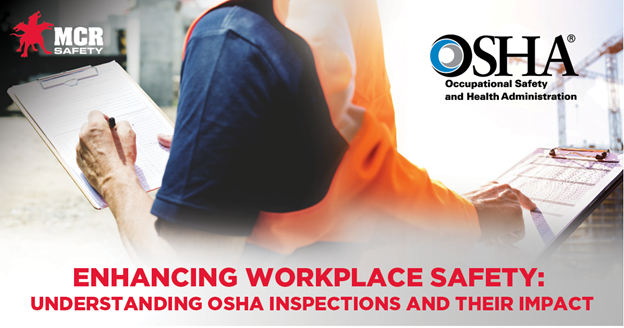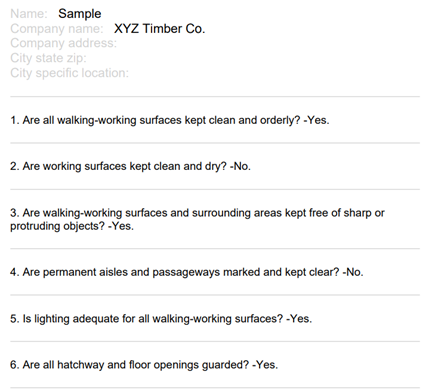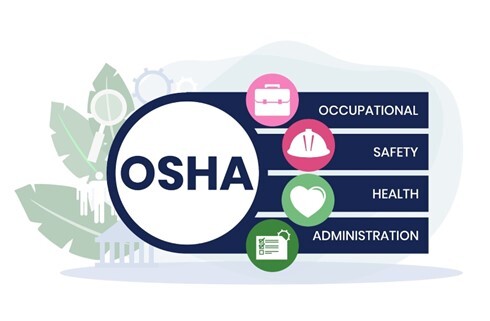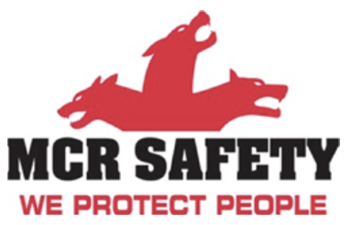Enhancing Workplace Safety: Understanding OSHA Inspections and Compliance
Posted by Anthony Webb on Apr 8th 2025
Enhancing Workplace Safety: Understanding OSHA Inspections and Compliance
Ensuring workplace safety is a fundamental responsibility for organizations across all industries. Not only is it the right thing to do to protect employees, but failing to prioritize safety can have severe financial consequences for a company. The Occupational Safety and Health Administration (OSHA) enforces workplace safety regulations and imposes steep penalties for violations, with fines for serious infractions reaching $15,000 or more per violation. Beyond financial penalties, non-compliance can lead to workplace accidents, employee injuries, and reputational damage, negatively impacting business operations.
OSHA inspections are pivotal in identifying workplace hazards and ensuring companies comply with mandated safety regulations. The agency prioritizes imminent dangers—situations where workers face an immediate risk of serious injury or death—and requires employers to take immediate corrective action to address these identified hazards. Additionally, OSHA investigates fatalities and catastrophic events that result in the hospitalization of three or more employees, requiring employers to report such incidents within eight hours. Inspections can be triggered by employee complaints, referrals, industry targeting programs, or follow-ups on past violations.

This article provides a comprehensive breakdown of the OSHA inspection process, highlights common violations, outlines best practices for compliance, and offers valuable safety resources. By understanding OSHA’s role and proactively preparing for inspections, organizations can enhance workplace safety, protect employees, and maintain compliance with federal safety standards.
What happens during an OSHA inspection?

OSHA inspections are structured to evaluate workplace safety and identify potential hazards. With over 7 million worksites under OSHA’s jurisdiction, not every complaint results in an immediate on-site visit. Instead, OSHA prioritizes inspections based on the severity of the issue, focusing first on imminent dangers where employees are at immediate risk of death or serious harm. If a reported hazard is deemed a lower priority, OSHA may contact the employer via phone, outline the concern, and request a written response. If the employer provides satisfactory corrective measures and the complainant agrees, an on-site inspection may not be necessary. However, if concerns remain unresolved or are of significant risk, OSHA initiates a multi-stage process to ensure compliance and workplace safety.
The inspection begins with preparation, during which OSHA compliance officers review the site’s safety history, applicable regulations, and potential hazards. They also ensure they have appropriate protective gear and the necessary testing instruments to assess risks effectively. Upon arrival, the officer presents their credentials, including an official ID with a photograph and unique serial number, to verify their authority. Next, an opening conference occurs wherein the compliance officer explains why the workplace was selected for inspection, outlines the scope of the investigation, and discusses inspection procedures. The employer must designate a representative to accompany the officer during the inspection, while an employee representative also has the right to be present. Additionally, the compliance officer may interview employees privately to gain firsthand insights into workplace conditions.

Following the conference, the walkaround inspection begins. The compliance officer and representative(s) tour the facility, looking for hazards, reviewing safety procedures, and examining workplace injury records. They also check whether required OSHA safety posters and notices are appropriately displayed. In some cases, if violations are immediately correctable, the officer may point them out during the walkaround, though they will still be documented in the official findings. Finally, the inspection concludes with a closing conference, where the OSHA compliance officer discusses the findings, potential violations, and next steps. Employers may discuss concerns informally with OSHA, contest citations and penalties, or seek additional consultation services. Understanding this process is crucial for businesses, as proactive safety management can help prevent costly violations and ensure a safer work environment.
The OSHA Inspection Process: The Core Stages
- Preparation & Opening Conference – An OSHA compliance officer reviews the site’s safety history, presents credentials, and explains the purpose and scope of the inspection.
- Walkaround Inspection – The compliance officer evaluates the workplace, identifies hazards, reviews records, and interviews employees.
- Closing Conference & Next Steps – The OSHA compliance officer discusses findings, outlines potential violations, and informs the employer about necessary corrective actions, appeals, or consultation services.
Understanding these steps allows businesses to anticipate compliance challenges and proactively improve workplace safety. However, many OSHA violations are shared across multiple industries, and failure to address them can lead to costly penalties and increased workplace risks. In the next section, we’ll explore some of the most frequently cited OSHA violations and how businesses can avoid them.
Common OSHA Violations

During OSHA inspections, certain violations appear consistently across multiple industries. Many of these violations stem from failure to follow fundamental safety protocols, leading to avoidable workplace injuries, citations, and financial penalties. Year after year, OSHA identifies its most frequently cited violations, which serve as a roadmap for businesses looking to strengthen workplace safety and ensure compliance with federal regulations.
Common violations include fall protection failures, lack of proper hazard communication, missing machinery safeguards, and electrical safety hazards. These violations don’t just put workers at risk—they can result in hefty penalties and operational disruptions for the company.
OSHA categorizes violations into four key types, each reflecting different levels of severity and enforcement:
- Willful Violations – are deliberate infractions where an employer knowingly fails to comply with OSHA standards or shows blatant disregard for employee safety. These violations carry the highest penalties and can even lead to criminal charges if an employee is seriously harmed or killed.
- Serious Violations – are noted when a workplace hazard is highly likely to cause death or severe physical harm, and the employer should have known about it or taken action to correct it.
- Repeated Violations – This happens if a business previously received an OSHA citation for the same or a similar issue and failed to address it. The company can be cited for a repeated violation in these cases, often with escalating fines.
- Other-than-serious violations – are directly related to workplace safety and health but are less severe and do not pose an immediate risk of injury or death. However, they still require corrective action to maintain compliance.
By staying informed about common compliance issues, companies can prevent accidents, reduce penalties, and foster a safety culture. The following section will explore how businesses can prepare for OSHA inspections and develop strong safety management systems to ensure long-term compliance.
Preparing with an Inspection Checklist

Preparing for an OSHA inspection is essential to ensure a smooth process and demonstrate the business’s commitment to workplace safety. Proactive safety management is the cornerstone of adequate inspection preparation. As we highlight in our article Safety Hazard Assessment Principles and PPE, regular self-audits and inspections allow businesses to identify and address potential hazards before an OSHA inspection occurs. It is crucial to rectify any identified safety issues and compliance gaps promptly.
Implementing a structured inspection checklist is one of the most effective ways to prepare for an OSHA inspection. A well-structured OSHA compliance checklist ensures businesses meet regulatory requirements while promoting a safer work environment. Though every workplace will have unique considerations, a typical checklist addresses these key areas of compliance:
- General Workplace Conditions – Ensure housekeeping is maintained, floors are hazard-free, emergency exits are marked, and lighting is adequate.
- Hazard Communication – Verify that all hazardous materials are labeled correctly and that Safety Data Sheets (SDS) are accessible to employees.
- Personal Protective Equipment (PPE) – Confirm that PPE is provided based on job hazards and that employees are trained in proper usage.
- Electrical Safety – Inspect electrical panels for accessibility, ensure the wiring is in good condition, and verify that ground fault circuit interrupters (GFCIs) are installed where required.
- Machine Guarding – Evaluate machinery for proper safety guards and confirm employees follow lockout/tagout procedures.
- Fire Safety – Confirm fire extinguishers are available, regularly inspected, and employees are trained in emergency response.
- Ergonomics – Assess workstation design, lifting techniques, and the availability of adjustable equipment to prevent musculoskeletal injuries.
- Training and Record-Keeping – Maintain accurate injury and illness records, document all safety training sessions, and post required OSHA notices in visible locations.
By consistently reviewing and updating these areas, businesses can comply with OSHA regulations and create a safer and more productive work environment.
OSHA Inspection Process Resources

A thorough understanding of OSHA inspections is essential for businesses seeking to maintain compliance and ensure workplace safety. Fortunately, OSHA provides numerous resources to help organizations navigate the inspection process, understand their rights and responsibilities, and proactively address safety concerns before an official visit occurs. These resources offer valuable insights into OSHA’s enforcement policies, inspection procedures, and compliance requirements, enabling businesses to prepare effectively and foster a safer work environment.
The official OSHA website is a key starting point, offering information, including frequently asked questions, inspection overviews, and guidance documents that clarify regulatory expectations. One of the most comprehensive resources is the OSHA Inspection Field Operations Manual (FOM), which provides a structured approach to conducting inspections. This manual outlines enforcement policies, details OSHA’s jurisdiction over various industries, and uniformly applies workplace safety and health standards.
In addition to general guidance, OSHA also provides industry-specific compliance assistance, fact sheets, and step-by-step guides designed to help employers better understand their safety obligations. These resources help businesses stay informed about evolving safety regulations and take necessary actions to address potential hazards before an inspection occurs. By leveraging these tools, employers can create a workplace that prioritizes safety, reduces risk, and fosters compliance with OSHA’s stringent safety standards.
For organizations looking beyond essential compliance, OSHA’s consultation services offer free, confidential advice to small and medium-sized businesses. These services help employers identify workplace hazards, improve safety programs, and ensure regulatory adherence—all without the risk of citations or penalties.
Key OSHA Resources for Inspection Preparedness
- OSHA Fact Sheet – Summarizes key aspects of the inspection process and common compliance issues.
- Step-by-Step Guide – Provides a structured approach to preparing for and navigating OSHA inspections.
- OSHA Compliance Assistance – Offers industry-specific guidance to help businesses meet safety requirements.
- Filing a Complaint – Outlines the process for employees or representatives to report unsafe working conditions.
MCR Safety Safety Resources:
By taking advantage of these resources, businesses can be proactive rather than reactive regarding workplace safety. Staying informed and implementing best practices ensures a safer working environment while minimizing the risk of violations and costly penalties.
Common Questions

What type of OSHA inspection is conducted when an immediate death takes place?
When a fatal workplace incident occurs, OSHA conducts a Fatality/Catastrophe (FAT/CAT) Inspection to investigate the circumstances leading to the accident. Employers are legally required to report any work-related fatalities within eight hours of the event and any workplace incidents resulting in inpatient hospitalization, amputation, or eye loss within 24 hours. These inspections are prioritized to ensure rapid response and thoroughly examine potential safety violations that could impact other employees.
During the investigation, OSHA compliance officers assess the worksite, review safety records, and interview employees to determine whether existing safety protocols were followed and if any regulatory violations contributed to the fatality or serious injury. The findings from a FAT/CAT inspection may result in citations, penalties, or mandatory corrective actions. Employers may face significant fines or legal consequences if major violations are found. The results of these inspections are also reported to OSHA’s National Office via the Regional Administrator, ensuring high-level oversight.
What are the four major stages of an OSHA inspection?
OSHA inspections follow a structured four-stage process designed to assess workplace safety while maintaining procedural transparency thoroughly:
- Inspection Preparation – Before arriving at a worksite, OSHA compliance officers review the company's safety history, previous violations, and industry standards. They also ensure they have the proper personal protective equipment (PPE) and testing instruments necessary for a comprehensive evaluation.
- Opening Conference – The inspection begins with a meeting between the compliance officer and the employer (or their representative). During this stage, the officer explains the reason for the inspection, its scope, and what workplace areas will be assessed. The employer must provide relevant safety documents, including training records, previous safety audits, and incident reports.
- Walkaround Inspection – The compliance officer, accompanied by an employer representative and, potentially, an employee representative, thoroughly examines the worksite. They assess physical conditions, machinery, equipment, and workplace practices, ensuring compliance with OSHA safety standards. Employees may be interviewed during this phase to learn about safety procedures and potential hazards.
- Closing Conference – Once the walkaround is complete, the OSHA compliance officer holds a final meeting with the employer to present their preliminary findings. The compliance officer discusses any observed violations and potential corrective actions and outlines the next steps in the compliance process. Employers are also informed of their rights regarding contesting citations or appealing penalties.
Understanding these inspection stages helps businesses navigate OSHA procedures more effectively, ensuring a cooperative and efficient process. By being proactive in workplace safety, companies can avoid unnecessary penalties and create a safer environment for employees.
Keeping You Informed and Safe
![]()
MCR Safety provides in-depth resources on various OSHA-related topics, including a general administration overview, OSHA incident rates, workplace safety programs, and essential training such as OSHA 10 and OSHA 30 certification courses. This article has broken down the OSHA inspection process and highlighted its critical role in enhancing workplace safety and protecting employee well-being.
Understanding the inspection procedure, recognizing common violations, and utilizing OSHA resources allows businesses to establish a strong compliance framework that meets regulatory requirements and promotes a safer work environment. Adherence to OSHA regulations does more than just prevent fines and penalties—it fosters a healthier, more productive workforce and ensures that safety remains a top priority. MCR Safety, We Protect People!
Click the image below to leave us comments, questions, or concerns.
For over 50 years, MCR Safety has proven to be a world leader in gloves, glasses, and garments. Whether it's keeping workers informed about OSHA or arming them with advanced PPE, we are there providing solutions to workplace hazards. It's all part of our commitment to protect people.
No matter your industry, we have the personal protective equipment you need.

Learn more about MCR Safety by checking out our most recent video. For more information, browse our website, request a catalog, find a distributor, or give us a call at 800-955-6887.


